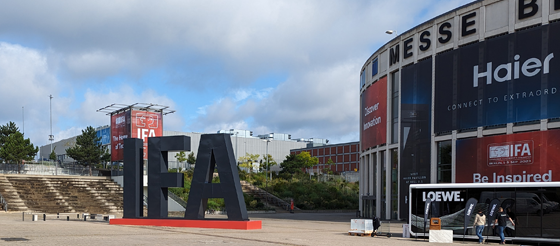As the great British weather improves our attention moves to making the most of every moment we can enjoy outdoors, in our gardens, balconies or public spaces with friends, family and pets. We do so at home with a view to bring the indoors outdoors and live alfresco to eat, drink, play, listen and watch. As a result, this change in habits opens up new trends for the consumer electronics industry and opportunities across many categories for all retailers.
With the advent of the bifold door, the garden as an additional room to your house is now common and therefore with more families spilling out into the garden, it’s not that unusual to see an outdoor kitchen combined with dining and living spaces which convert into entertaining and cinemas spaces at dusk.
So let’s start with cooking outdoors and the new appliances appearing on the wish lists of would-be chefs looking beyond traditional BBQs and wanting to offer their guests more than the usual fare of burgers, bangers and cremated chicken drumsticks. Peaking into the world of Grilling opens up a plethora of options for homeowners with buying decisions being made for a variety of reasons including their culinary ambitions, the desire to impress guests, the outdoor space available and of course budget.
The Grilling category includes portable grills, smokers and outdoor ovens and in the UK is estimated to be worth around £177 million currently and is expected to reach almost £200 million within 5 years, growing at a CAGR of 3.70% during the forecast period (2024-2029).
One brand leading the way here is Shark Ninja, which offers a range of innovative outdoor cooking appliances to meet the needs of many consumers and in doing so, enhancing their culinary experiences. The Ninja outdoor range, which has been marketed heavily over recent months, includes the Woodfire Electric Outdoor Oven, Ninja Woodfire Electric BBQ Grill & Smoker & the Woodfire Pro Connect XL Electric BBQ Grill & Smoker, which as the name suggests, features smart connectivity allowing the user to control their BBQ & monitor cooking progress on their phone.
Another area for growth is the outdoor Pizza oven market which is anticipated to grow at a considerable rate over the next 5 years. A number of brands are making their mark including Gozny, Ooni and Witt, all of whom offer a modern, convenient, user-friendly take on the pizza oven. Together with outdoor electric grills, pizza ovens are something home appliance retailers should certainly consider ranging, opening up sales opportunities in other areas of the home.
One step on from the outdoor appliances are actual outdoor kitchens, something that frequently makes me envious. Imagine having an outdoor kitchen equipped with built-in appliances like refrigerators and sinks. Standard in smart Mediterranean villas for decades but now popping up in Acacia Avenue across Britain, this is a trend that for many who sell kitchens, may see their business evolve over time. Believe it or not, the outdoor kitchen category grew globally from $6.3 billion last year to $6.7 billion in 2024 and is estimated to grow to almost $9 billion by 2033.
So once you’ve whipped up a culinary feast in your outdoor kitchen, what’s next? Well perhaps kick back and set the mood with a smart outdoor lighting system allowing homes to control and customise their setups with ease. These app controlled solutions, from the likes of Philips Hue, can be programmed to change colours, adjust brightness levels and can be combined with your music via an outdoor audio system to enhance the outdoor living experience. We all know that music adds ambience to outdoor spaces and all-weather solutions are becoming increasingly popular, with weatherproof speakers and sound systems specifically designed for outdoor use that are wireless and Bluetooth-enabled, allowing users to stream music from their smartphones or other devices.
To complete the indoors outdoors experience, CE retailers should be adding some outdoor TV options to their ranges, offering their customers the opportunity of immersive outdoor cinema experiences, day or night. The category is starting to build momentum and unsurprisingly Samsung is at the forefront with The Terrace which comes in both 65” and 75” screen sizes and is specifically designed for open-air use. Another brand to watch is Sylvox which has a much larger range of outdoor TVs. Aside from being weatherproof, they are also more durable and resistant to extreme temperatures and feature exceptionally bright, anti-reflection screens so you can enjoy your favourite content even on the sunniest of days. Bearing in mind the high price points, the large screen sizes and the intended setting for these TVs, I would suggest that offering an installation service would be a real benefit to your customers.
So, British weather permitting, it is entirely possible to create a new heart of the home, outdoors. By transforming your garden into a living, dining and entertainment space, homeowners can truly embrace an al fresco lifestyle. As we head towards summer, retailers can capitalise upon the opportunity by complementing their usual in-store offering with something different, where your customers can let their imaginations run wild!
To read the published article written by Dan Todaro, Managing Director please visit ERT
Photo From Brown Jordan Outdoor Kitchens










